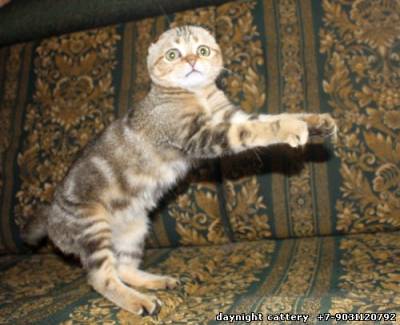Main » 2013 September 13 » Scottish Fold, About This Breed
12:56 Scottish Fold, About This Breed | |
| n 1961 a shepherd by the name of William Ross spotted the
first known Scottish Fold cat at a farm near Coupar Angus
in the Tayside Region of Scotland, Northwest of Dundee.
Ross asked the owners if he could have one of the kittens,
and proceeded to develop the breed from the original, Susie,
a white barn cat.
The unique thing about this cat was that her ears folded
forward and downward on her head. The resulting look
gave the impression of a "pixie,” "owl,” or "teddy bear” that
has captured the hearts of many American cat fanciers and
judges. The Scottish Fold was granted championship status
by The Cat Fanciers’ Association (CFA) in 1978.
Scottish Folds come in two types: folded ear and straight
(normal) ear. The folded ear is produced by an incomplete
dominant gene and is the result of a spontaneous mutation.
Over the last two decades the Scottish Fold has developed
a look all its own…even though allowed outcrosses include
American Shorthairs and British Shorthairs. The Fold does
not necessarily resemble the American Shorthair’s hard,
powerful "working cat” body and squared-off muzzle. Nor
does it look like the British Shorthair’s massive, compact
body, short legs, and flat planed top-head. The Fold, instead,
is a medium cat with a rounded, well-padded body and a
short, dense, and resilient coat. It has large, round, broadly
spaced eyes full of sweetness; well-rounded whisker pads and
a short nose with a gentle curve in profile.
Scottish Fold kittens are born with straight ears. At about
three to four weeks of age, their ears fold…or they don’t! It is
usually around eleven to twelve weeks of age that the breeder
can determine the quality (pet, breeder or show). Presently,
only folded ear cats of Scottish lineage are permitted in the
show ring, and naturally, every breeder wants to produce show
cats. The straight ear progeny of Scottish Folds, nevertheless,
are invaluable to the breeding program.
Due to the rarity of the Fold, AND due to the fact that not
every kitten born has folded ears, it is very hard for the supply
to keep up with the demand.
Scottish Folds are hardy cats, much like their barnyard
ancestors. Their disposition matches their sweet expression.
They have tiny voices and are not extremely vocal. They adore
human companionship and display this in their own quiet way.
Scottish Folds adapt to almost any home situation and are
as comfortable in a room full of noisy children and dogs as
they are in a single person’s dwelling. They don’t usually panic
at shows or in strange hotel rooms, and they adjust to other
animals extremely well.
When inspecting a Fold for purchase, be sure to determine
the flexibility of the tail and check the feet and legs. There
must be no hint of thickness or lack of mobility due to short,
coarse legs or splayed toes. Determination of tail flexibility
can be accomplished by moving your hand down the tail
in a VERY GENTLE, slightly upward-arching movement.
With proper flexibility, this arching movement can be made
without discomfort to the cat. Again, when doing this
PLEASE BE GENTLE!
The Scottish Fold is an undemanding cat. A clean
environment, proper nutrition, and generous doses of love
are its only requirements. | |
|
| |
| Total comments: 0 | |
